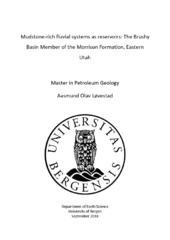Mudstone-rich fluvial systems as reservoirs: The Brushy Basin Member of the Morrison Formation, Eastern Utah
Master thesis
Permanent lenke
https://hdl.handle.net/1956/18614Utgivelsesdato
2018-09-27Metadata
Vis full innførselSamlinger
- Department of Earth Science [1050]
Sammendrag
Mudstone-rich fluvial systems are common in the sedimentary record, such as the Triassic of the Barents Sea, but have received little scientific attention compared to their sandstonerich counterparts. However, mudstone-rich fluvial systems often have large river channels which are easily imaged on seismic data, and thus make good exploration targets. The late stages of the Jurassic sedimentary succession of Utah, USA, comprise of a collection of lowgradient, mudstone-rich fluvial continental deposits known as the Brushy Basin Member of the Morrison Formation. This thesis investigates the Jurassic Brushy Basin Member as an analogue to mudstone-rich fluvial reservoirs and offers new insight into distributary fluvial systems. Fieldwork was done on a 2x2 km, v-shaped outcrop which offers a high degree of threedimensionality. Data acquisition was done through combining traditional fieldwork techniques with modern digital acquisition techniques and a virtual model of the outcrop was constructed. Through interpreting and correlating logs with the virtual-outcrop, facies associations and their spatial organization was identified and understood. A conceptual geological model was constructed which schematically captures the upwards changes in the fluvial system. A reservoir model based on the geological model was then built with the goal of flow-simulating oil production from the reservoir model. The results from studying the Brushy Basin Member implies a retrograding distributary fluvial system, with an upwards decrease in channel-belt width, thickness, amalgamation and interconnection. This interpretation has not been described in previous work. Production results from flow simulating the reservoir model shows that a mudstone-rich fluvial system highly depend on channel-to-channel connection which can be established through crevasse-splays. In exploration of new and poorly understood mudstone-rich fluvial systems, sub-seismic channels and crevasse-splays should be considered an upside in terms of connectivity and reservoir volumes.
Utgiver
The University of BergenOpphavsrett
Copyright the Author. All rights reservedBeslektede innførsler
Viser innførsler beslektet ved tittel, forfatter og emneord.
-
Sedimentary anatomy and hydrological record of relic fluvial deposits in a karst cave conduit
Bella, Pavel; Gradziński, Michał; Hercman, Helena; Leszczyński, Stanisław; Nemec, Wojciech (Journal article; Peer reviewed, 2021)This case study from the renowned Demänová Cave System in the Carpathians of Slovakia demonstrates that the conventional methods of fluvial sedimentology, combined with an allostratigraphic mapping and speleothem U-series ... -
The spatial-temporal geomorphology of meandering river channels in distributive fluvial systems
Zachariah, May Britt Kjærevik (Master thesis, 2019-06-28) -
Sedimentology and Geometry of Fluvial and Deltaic Sandbodies in the Eocene Green River Formation, Eastern Utah
Spinnangr, Øystein (Master thesis, 2014-06-02)A large part of the world’s remaining hydrocarbon reserves are located in reservoirs of fluvial origin. The main building blocks of these reservoirs are channel‐belt sandbodies with varied geometries and spatial stacking. ...
